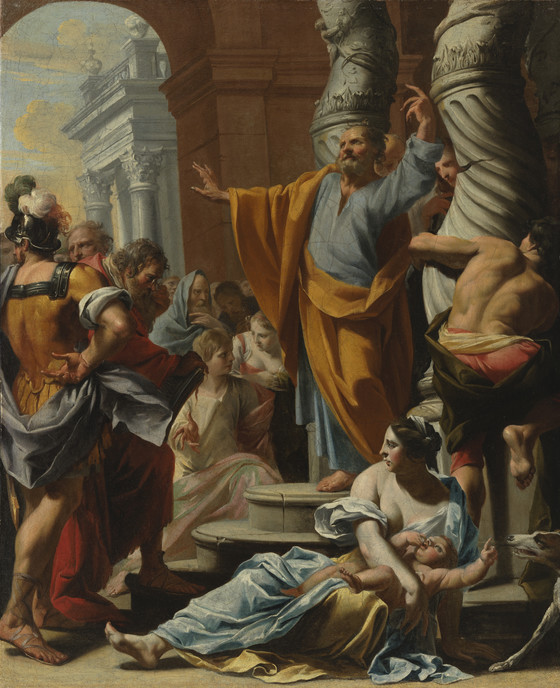The daily lectionary has recently offered two passages from the Second Letter of Peter – certainly one of the least known of the New Testament books. Indeed, it seems to have entered the New Testament canon, belatedly, by the skin of its teeth (or parchment). Some credible scholars date it as late as 130 A.D.; though others place it towards the end of the first century. So both in terms of its history, its lectionary use, and its impact on the lives of clergy and laity alike, Second Peter seems decidedly peripheral.
Which is regrettable – especially today. For, I think, we urgently need to heed its message. Which is, what? Happy you asked!
Second Peter presents itself as the testimony of the Apostle Peter to communities threatened by “false teachers,” who are importing “destructive heresies,” even to the point of “denying the Master who bought them.” (2 Peter 2:1) Of particular concern to the author is their denial of the eschatological heart of the Christian message. Jesus Christ will return as Lord and Judge of the living and the dead.
Moreover, this denial has present consequences. A salient conviction of the author is that conduct derives from doctrine. Change the doctrine and wayward conduct, both adulterous and covetous (2:14), will follow in its wake.
Thus the word “remember” serves as a leitmotif in the letter. The author, speaking in the name of the Petrine tradition, urges remembrance of the true doctrine handed down from the Apostles, the right way of life in steadfast expectation of the parousia, the coming of the Lord. Its seeming delay is due to God’s forbearance and mercy, not to any change of salvific plan and promise (3:9).
Remarkable, and too little appreciated, is Second Peter’s high Christology. The opening greeting unites “Simon Peter, slave and apostle of Jesus Christ,” with all who share the faith “in the righteousness of our God and Savior, Jesus Christ” (1:1) – one of the few New Testament passages that explicitly designates Jesus as “God.”
No doubt, the thrust of the letter’s teaching is to affirm the sureness of the Lord’s eschatological coming and the decisive day of universal judgment. Famously, Second Peter predicts the transformation of all created reality and the promise of “new heavens and a new earth in which righteousness dwells.” (3:13)

Yet a close reading also reveals intimations of “realized eschatology.” Not merely the still to come, but the already present. The Greek word parousia suggests both presence and coming. The one who is coming is also the one who is really present among the faithful, the source of their life and hope.
In this regard, it is noteworthy that Second Peter evokes the memory of the Lord’s Transfiguration – the only explicit reference outside the Synoptic Gospels. He writes: “We did not devise cleverly concocted fables when we made known to you the power and presence/coming (parousia) of our Lord Jesus Christ. For we were with him on the mountain when he received honor and glory from God the Father, and we heard the voice from the heavens: ‘this is my Son, the Beloved, in whom I am well pleased’!” (1:16–18)
The Transfiguration testifies to the powerful presence of the Lord, pre-figuration and pledge of Christ’s final epiphany.
Thus what is at stake for Second Peter is not less than Christianity’s defining belief. He is concerned with “eschatology,” because the Gospel proclaims that Jesus Christ is himself the Eschatos: God’s definitive Word, God’s revelatory presence among us. This presence will, indeed, be consummated at the end time, but is already operative in these present days of grace. God has no other Word of grace and of judgment than his beloved Son.
Jesus Christ, for the New Testament, is the new paradigm of humanity, whether confessed as “Son of Man,” “new Adam,” or “Word made flesh.” Second Peter was ultimately accepted into the Canon because it corresponds to this Christological measure.
Throughout, the letter exhorts its readers to “knowledge of the Lord.” Such knowledge and the way of life it inspires guide believers to “become sharers in the divine nature.” (1:4) This bold assertion, so foundational to the Orthodox spirituality of theosis or divinization, has tainted Second Peter in the eyes of liberal Protestant exegetes and theologians.
For notwithstanding the letter’s insistence on “holy living” (3:11), the Seer of the Transfiguration is more the mystic than the moralist. Of course, holy living matters; but it is ever living according to the pattern of the Holy One.
Towards the end of the letter, the author speaks of “waiting for and hastening the coming (parousia) of the day of the Lord.” (3:12) It is no passive waiting. One might ask, then: “how does one hasten the coming of the Lord?” And the response seems to be: by “growing in the grace and knowledge of our Lord and Savior, Jesus Christ.” (3:18) For the author of Second Peter, divinization is Christification.
Jesus Christ’s life-bestowing coming in our present and our growing conformity to him presage and prepare his future parousia. He initiates the new creation now.
John Calvin voiced reservations about the letter’s attribution to the Apostle Peter. Nevertheless, he exclaimed: “I dread to repudiate it.” We too should dread to repudiate it. Rather, we should take pains not to relegate it to the periphery of our spiritual discernment. It represents priceless testimony to the Christic center of our faith.
*Image: St. Peter Preaching in Jerusalem by Charles Poërson, 1642 [Los Angeles County Museum of Art]














